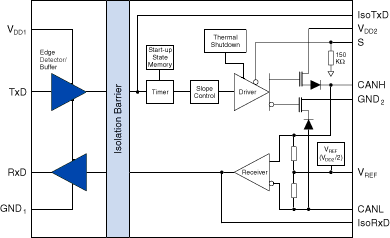|
Daylight
Saving Time
ends Sunday, November 4. “Spin” your clocks back an hour.
|
|
|
|
NVE will be closed Thursday and Friday, November 22 and 23. |
|
|
|
|
|
 |
|
|
 Isolated CAN Evaluation Board Isolated CAN Evaluation Board |
|
|
This Evaluation Board provides a complete isolated CAN node using the revolutionary IL41050TA-3E isolated transceiver.
The board is fully ISO 11898 CAN compliant and accommodates 3 volt to 5.5 volt supplies. It provides screw terminal connections, termination resistors, and pull-up resistors.
 Isolated CAN Evaluation Board
Isolated CAN Evaluation Board
Advanced features facilitate reliable bus operation. Unpowered nodes do not disturb the bus,
and a unique non-volatile programmable power-up feature prevents unstable nodes. The
devices also have a hardware-selectable silent mode that disables the transmitter.
Designed for harsh CAN and DeviceNet environments, IL41050TA transceivers have transmit
data dominant time-out, bus pin transient protection, a rugged Charged Device Model ESD
rating, thermal shutdown protection, and short-circuit protection. Unique edge-triggered
inputs improve noise performance.
Download Manual >

|
 |
|
|
Recent Exhibitions |
|
|
New NVE CAN transceivers and other IsoLoop isolated bus transceivers were featured at Vienna Tec in Vienna, Austria, in cooperation with Hy-Line Power Components.
|
 |
|
|
Upcoming Exhibition |
|
|
NVE distributor IS-LINE will be exhibiting at Electronica, November 13 to 16 in Munich, Germany. The exhibit will include NVE magnetic field sensors.
|
 |
|
|
Applications Corner |
|
|
Isolating CAN
CAN bus isolation higher speed and more reliable operation by eliminating ground loops and reducing susceptibility to noise and EMI. And, in high-voltage Battery Management Systems, isolation improves safety.
NVE offers feature-rich
stand-alone CAN transceivers such as the ground-breaking IL41050TA:

IL41050TA Isolated CAN Transceiver Block Diagram
There are also several two-channel, bidirectional isolators, including unique MSOPs. All have best-in-class 10 ns propagation delay. This minimizes loop delay and maximizes speed over a given bus length.
This technical video has more:
|
 |
|
|
Halloween Application Corner |
|
|
 Speed Specs Speed Specs
Don’t Have to Be Scary
PWD, skew, jitter, and more. Isolator speed specs don’t have to be scary.
But it’s important to understand speed parameters. Because fast is worthless if it’s garbled.
Pulse-Width Distortion is the maximum difference in rising and falling prop delays. The asymmetry distorts the pulse width. This is important in pulse width modulation and delta-sigma ADCs.
Channel-to-Channel Skew is the difference in propagation delay between channels in the same device. It can be either direction. It's important for clocked systems.
Propagation Delay Skew is the difference in propagation delay between devices. It's larger than Channel-to-Channel Skew, and can be a trap for the unwary in synchronous systems. This is an area where IsoLoop isolators shine.
Jitter is another under-reported parameter. It's the variation in the pulse edge position and can cause particularly nasty distortion.
Data Rate is the maximum rate at which data can be transmitted Various device limitations can make claimed data rate unusable. For example, one competitor's datasheet requires zero rise and fall time and exactly 50% duty cycle, which is obviously unrealistic.
NVE parts are best in class for speed parameters. Watch this technical
video for more “unskewed,” info:
Email the Isolator Applications Desk > |
|

